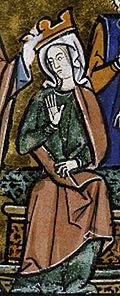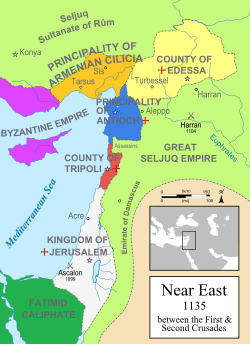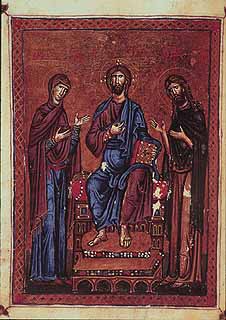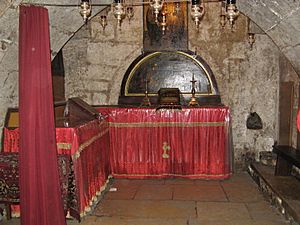Melisende, Queen of Jerusalem facts for kids
Quick facts for kids Melisende |
|
|---|---|
 |
|
| Queen of Jerusalem | |
| Reign | 1131–1153 |
| Predecessor | Baldwin II |
| Successor | Baldwin III |
| Co-Sovereign | Fulk Baldwin III |
| Born | 1105 County of Edessa |
| Died | 11 September 1161 (aged 55–56) Jerusalem |
| Burial | Shrine of Our Lady of Josaphat |
| Spouse | Fulk, King of Jerusalem |
| Issue | Baldwin III of Jerusalem Amalric I of Jerusalem |
| House | House of Rethel |
| Father | Baldwin II of Jerusalem |
| Mother | Morphia of Melitene |
| Religion | Roman Catholicism |
Melisende (born 1105 – died 11 September 1161) was a powerful queen who ruled the Kingdom of Jerusalem. She was queen from 1131 to 1153. After that, she served as a regent for her son, helping him rule from 1153 to 1161. Melisende was the oldest daughter of King Baldwin II of Jerusalem and Princess Morphia of Melitene from Armenia. Her story shows how a strong woman could lead a kingdom in the Middle Ages.
Contents
Becoming Queen of Jerusalem
Jerusalem was captured by Christian knights from Europe in 1099. This happened during the First Crusade. Melisende's family came from a place called Rethel in France. Her father, Baldwin, was a crusader knight. He created the Crusader State of Edessa. He married Morphia, an Armenian princess. This marriage helped make strong alliances in the region.
Melisende's Early Life
Melisende was named after her grandmother. She grew up in Edessa until she was 13 years old. Then, her father was chosen to be the King of Jerusalem. He became king after his cousin, Baldwin I. By this time, Baldwin II and Morphia had three daughters. These were Melisende, Alice, and Hodierna.
A King's Devotion
Some people told King Baldwin II to divorce Morphia. They wanted him to marry a younger woman. This new wife could have better political connections. She might also give him a son to be his heir. But Baldwin II loved his wife very much. He refused to divorce her. He even waited to be crowned king until Christmas Day 1119. This was so Morphia and their daughters could be there. The queen was crowned alongside him.
Morphia's Strength
Morphia did not usually get involved in daily politics. But she was ready to act when needed. In 1123, Melisende's father was captured during a battle. Morphia hired Armenian fighters to find him. In 1124, she helped negotiate his release. She even traveled to Syria to do this. She gave their youngest daughter, Ioveta, as a hostage. This was a promise that the king's ransom would be paid. Both of Melisende's parents were strong role models for her. She grew up in a land often at war.
Training to Rule
As the oldest child, Melisende was raised to be the heir presumptive. This meant she was expected to inherit the throne. Women in the Crusader states often lived longer than men. This was partly because men died in constant wars. So, women had a lot of influence. They helped keep society stable. Women who inherited land usually did so because men died in war.
Queens Who Ruled
Sometimes, women were recognized as queen regnant. This meant they ruled in their own right. But they rarely used their power directly. Instead, their husbands would rule through their wives' rights. This was called jure uxoris. However, some queens did rule directly. These included Urraca of Castile (1080–1129) and Eleanor of Aquitaine (1122–1204).
Melisende's Growing Power
During her father's reign, Melisende was called "daughter of the king and heir of the kingdom of Jerusalem." She was more important than other nobles and church leaders at ceremonies. She was also increasingly involved in official tasks. These included making money, giving out land, and writing diplomatic letters. Baldwin trained his daughter to be a good ruler. Melisende also had the support of the Haute Cour. This was a royal council of nobles and church leaders.
Finding a Husband
King Baldwin II knew Melisende needed a powerful husband. This husband would protect her inheritance and future children. Baldwin asked King Louis VI of France to suggest a French noble. The connection to France was important for Jerusalem. The new kingdom needed people and support from France, Germany, and Italy.
Louis VI chose Fulk V, the Count of Anjou. Fulk was known as a rich crusader and military leader. He was also becoming a threat to Louis VI himself. Fulk's son, Geoffrey, was married to Empress Matilda. She was the chosen heir to the English throne. This meant Fulk could become the grandfather of a future English ruler. Fulk's wealth and connections made him as powerful as the King of France.
Fulk's Demands
Fulk insisted on being the only ruler of Jerusalem. Baldwin II first agreed, but then changed his mind. Baldwin II saw Fulk as a threat to his family. He worried Fulk would push Melisende aside. He feared Fulk would make his own son, Elias, the heir to Jerusalem.
Fulk and Melisende married on 2 June 1129 in Jerusalem. In 1130, Melisende had a son, the future Baldwin III. Her father then made sure Melisende would rule after him. Baldwin II held a special ceremony. He made Melisende, her son Baldwin III, and Fulk joint rulers. To make Melisende's position stronger, Baldwin II named her the only guardian for young Baldwin. He left Fulk out.
When Baldwin II died in 1131, Melisende and Fulk became joint rulers. A historian named William of Tyre wrote that Melisende had the right to rule. He said she was "a queen beloved by God, to whom it passed by hereditary right."
Fulk's Actions
However, Fulk used his knights to keep Melisende from making decisions. He stopped her from giving out titles or favors. He openly ignored her right to rule. Baldwin II's fears seemed to be true. The Haute Cour members were upset. Their own power would be less if Fulk kept dominating. Fulk ruled in a very strict way. This was different from how the people in Jerusalem were used to being governed.
Challenges to Her Rule
Fulk used problems in his marriage as a political tool. In 1134, he accused Hugh II of Le Puiset, the Count of Jaffa, of being involved with Melisende. Hugh was the most powerful noble in the kingdom. He was very loyal to Melisende's father, Baldwin II. This loyalty now extended to Melisende. Historians like William of Tyre say Melisende was not guilty. They point out that Fulk favored new crusaders from France over the local nobles. If Melisende had been guilty, the Church and nobles would not have supported her later.
Hugh's Rebellion
Hugh joined forces with the Muslim city of Ascalon. He was able to fight off the army sent against him. But he could not hold his position forever. His alliance with Ascalon made him lose support at court. The Patriarch helped negotiate a peace. Hugh was sent away for three years. Soon after, someone tried to kill Hugh. People thought Fulk or his supporters were behind it. This was enough for the queen's supporters to challenge Fulk openly.
Melisende Regains Power
Melisende's supporters took control of the palace. From 1135 onwards, Fulk's power quickly disappeared. One historian wrote that Fulk's supporters "went in terror of their lives" in the palace. William of Tyre wrote that Fulk "did not attempt to take the initiative, even in trivial matters, without [Melisende's] knowledge." Husband and wife made up by 1136. Their second son, Amalric, was born. When Fulk died in a hunting accident in 1143, Melisende was very sad.
Melisende had won. She was again seen giving out noble titles and land. She made appointments and offered royal favors. She held court and made decisions. William of Tyre wrote that Melisende was not just a regent for her son. She was a queen regnant. She ruled by her right as heir and by law.
Supporter of the Church and Arts
Melisende always had the support of the Church. They supported her when she was named heir. They supported her during her conflict with Fulk. And they supported her later when her son Baldwin III grew up. In 1138, she founded a large convent called St. Lazarus in Bethany. Her younger sister, Ioveta, became the head of this convent. Melisende gave the convent rich land in Jericho. She also provided beautiful furnishings and religious items. She wanted it to be as good as any religious house for men.
Generous Gifts
Historian Bernard Hamilton wrote that Melisende also gave large gifts to many religious places. These included the Holy Sepulchre and Our Lady of Josaphat. She also supported the Knights of Malta and a hospital for lepers.
Art and Books
Queen Melisende loved books and art. She had been exposed to different styles. This was because her parents came from French and Armenian backgrounds. She started schools for book makers and miniature painters. Miniature painting was used in medieval illuminated manuscripts. She also ordered the building of shops in Jerusalem. One famous market was called the "Street of Bad Cooking." This was a central market. It had special merchants and cooks. They provided food for the many pilgrims visiting the city.
Melisende was known for her love of books and her strong religious faith. She was a patron of books. Her husband, Fulk, knew this. After their big disagreement, he tried to make peace. He ordered a special book for her.
The Melisende Psalter
"The Melisende Psalter is an extraordinarily beautiful little book." It is now in the British Museum. It was a wonderfully decorated gift. It was small, only 21.6 centimeters tall. But it was richly decorated. Its front cover was covered in gold. It had six round pieces of ivory carved with scenes. It had a colorful silk spine. The ivory pieces had "turquoise, ruby, and emerald stones" around them. The book contained scenes of King David from the Old Testament. It also had a calendar with saints' days and prayers. All the first letters of chapters were beautifully decorated. The book was written in Latin. This shows that Melisende could read Latin. It also shows that noble women in the Middle East could be educated.
There is much evidence that this book was made for Melisende. It had Latin text suitable for a noblewoman. It focused on the Virgin Mary and Mary Magdalen. This suggests the nearby abbey Melisende supported. The only royal mentions in the book were of Melisende's parents. Only a king could afford such an expensive book. On the back cover, there is a carving of a bird labeled "Herodius." This bird is also called "fulica" or falcon. This was a clever play on King Fulk's name.
The artists who made the Melisende Psalter had a unique "Jerusalem style." This style was influenced by art from other places. Historian Hugo Buchtal wrote that Jerusalem had a busy workshop for books. It could easily make a very fancy royal book.
Reconciliation
We don't know how Melisende received this gift. But after it was made, the royal couple seemed stronger. Two things show they had made up. First, almost every official document after this was issued by Fulk. But it said "with the consent and the approval of Queen Melisende." Second, their second son, Amalric, was born in 1136. It is also said that Queen Melisende mourned greatly when her husband died in 1143.
The Second Crusade
In 1144, the Crusader state of Edessa was attacked. Queen Melisende sent an army to help. It was led by constable Manasses of Hierges. But Edessa fell.
Melisende sent a message to the Pope in Rome. This led to a call for a Second Crusade. The crusade was led by King Louis VII of France and Emperor Conrad III. Louis's wife, Eleanor of Aquitaine, also came. Eleanor had been chosen by her father to rule in her own right. This was just like Melisende.
Planning the Attack
In 1148, crusader leaders met in Acre. They planned their battle strategy. Conrad and Louis told 18-year-old Baldwin III to attack the Muslim city of Damascus. But Melisende, Manasses, and Eleanor wanted to attack Aleppo. Taking Aleppo would help them get Edessa back. The meeting ended with Damascus as their target.
Damascus and Jerusalem had been on good terms. They had a peace treaty. Attacking Damascus broke this treaty. Damascus would never trust the Crusader states again. Losing this friendly Muslim state was a big problem for Jerusalem. After 11 months, Eleanor and Louis left for France. This ended the Second Crusade.
Mother and Son
Melisende's relationship with her son was complicated. As a mother, she knew her son well. She was very close to her children. As a ruler, she might have been slow to give power to a young, untested leader. There was no pressure to give Baldwin power before 1152. This was true even though Baldwin became an adult in 1145. Baldwin III and Melisende were crowned together as co-rulers on Christmas Day, 1143. This was similar to Melisende's own crowning with her father.
Growing Tensions
Baldwin grew up to be a good military leader. But by age 22, he felt ready to take more responsibility. Melisende had only partly included him in her rule. Tensions grew between 1150 and 1152. Baldwin blamed Manasses for keeping his mother from him. The problem became very serious in early 1152. Baldwin demanded that the patriarch Fulcher crown him. He wanted to be crowned in the Holy Sepulchre without Melisende. The Patriarch refused. Baldwin then protested by walking through the city streets wearing laurel wreaths. This was like crowning himself.
Dividing the Kingdom
Baldwin and Melisende agreed to let the Haute Cour decide. The council decided that Baldwin would rule the northern part of the kingdom. Melisende would rule the richer areas of Judea and Samaria, and Jerusalem itself. Melisende agreed, but she had doubts. This decision would prevent a civil war. But it would also divide the kingdom's resources.
Some historians later criticized Melisende for not giving up her throne. But there was little reason for her to do so. Everyone saw her as an excellent ruler. Her rule was known as wise by church leaders and others. Baldwin had not shown much interest in ruling before 1152. The Church clearly supported Melisende. So did the nobles of Judea and Samaria.
A Son's Invasion
Baldwin was not happy with the division. Instead of finding another solution, he invaded his mother's lands. Baldwin quickly took Nablus and Jerusalem. Melisende, with her younger son Amalric, found safety in the Tower of David. The Church helped them make peace. Melisende was given the city of Nablus and nearby lands to rule for life. Baldwin III also promised not to bother her. This peace showed that Melisende still had great influence. She did not disappear into a convent.
Later Years and Influence
By 1153, mother and son had made up. Baldwin showed his mother great respect. Melisende's connections were very valuable. She was connected to her sister Hodierna and her niece Constance of Antioch. This meant she had direct influence in northern Syria. This was important because Baldwin had broken the treaty with Damascus.
Baldwin III was often away on military campaigns. He realized he needed good advisors. From 1154 onwards, Melisende was again involved in many of his official actions. In 1156, she made a treaty with merchants from Pisa. In 1157, Baldwin was fighting in Antioch. Melisende took the chance to capture el-Hablis. This place controlled lands beyond the Jordan River. Also in 1157, when patriarch Fulcher died, Melisende helped choose Amalric of Nesle as the new patriarch. Melisende also witnessed her son Amalric's marriage to Agnes of Courtenay in 1157. In 1160, she agreed to a gift her son Amalric made to the Holy Sepulchre. This may have been when her granddaughter Sibylla was born.
Death and Legacy
In 1161, Melisende had what seemed to be a stroke. Her memory was badly affected. She could no longer take part in state affairs. Her sisters came to care for her. She died on 11 September 1161. Melisende was buried next to her mother Morphia. This was at the shrine of Our Lady of Josaphat. Like her mother, Melisende left property to the Orthodox monastery of Saint Sabbas.
William of Tyre wrote about Melisende's 30-year reign. He said she was "a very wise woman, fully experienced in almost all affairs of state business." He added that she "completely triumphed over the handicap of her sex." She was able to handle important matters. He also wrote that Melisende "ruled the kingdom with such ability that she was rightly considered to have equalled her predecessors." Professor Bernard Hamilton said these comments show great respect. This was especially true for a time when women had fewer rights than men.
Images for kids
See also
 In Spanish: Melisenda de Jerusalén para niños
In Spanish: Melisenda de Jerusalén para niños







